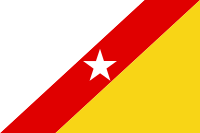
Training of F.N.L.A. soldiers in a camp in Zaire in 1973
| National Liberation Front of Angola Frente Nacional de Libertação de Angola | |
|---|---|
| President | Ngola Kabangu |
| Founded | 1954 (as the União dos Povos do Norte de Angola guerrilla movement), 1959 (as the União dos Povos de Angola guerrilla movement), 1961 (as the FNLA guerilla movement), 1992 (as a party) |
| Headquarters | Luanda, Republic of Angola |
| Ideology |
Civic nationalism[1][1] Christian democracy[1] Conservatism[2] |
| Political position | Centre-right |
| Seats in the National Assembly |
2 / 220 |
| Website | |
| http://www.fnla.net/ | |
| Party flag | |
 | |
|
Political parties Elections | |
The National Front for the Liberation of Angola (Portuguese language: Frente Nacional de Libertação de Angola , FNLA) was a militant centre-left organization that fought for Angolan independence from Portugal in the war of independence, under the leadership of Holden Roberto. Whilst left leaning, it distinguished itself from the Soviet-Union-backed MPLA, and was sponsored by the USA and Maoist China (which at the time was in a cold war with the Soviet Union). As such MPLA, FNLA and Unita were all pawns in the geopolitical struggles of the super powers of the time.
Ahead of the first multiparty elections in 1992, FNLA was reorganized as a political party. FNLA received 2.4% of the votes and had five Members of Parliament elected. In the 2008 parliamentary election, the FNLA received 1.11% of the vote, winning three out of 220 seats.[3]
Foreign support[]
Over the course of many years, the governments of Algeria, Tunisia, West Germany, Ghana, Israel, France, Romania, the People's Republic of China, South Africa, the United States, and Zaire actively supported and aided the FNLA.
The French government supplied men and loaned 1 million pounds sterling without interest.[4][5] The U.S. government began aiding the FNLA in 1961 during the Kennedy administration, and rerouted one-third of official aid to Zaire to go to the FNLA and UNITA.[4][6]
The Israeli government gave aid to the FNLA between 1963 and 1969. Holden Roberto visited Israel during the 1960s, and FNLA members were sent to Israel for training. During the 1970s the Israeli government shipped arms to the FNLA through Zaire.[7]
The People's Republic of China began supplying the FNLA with arms in 1964. It gave the FNLA military equipment and at least 112 military advisers.[8] The Romanian government delivered arms to the FNLA in August 1974.[9]
See also[]
- Revolutionary Government of Angola in Exile
- African independence movements
- Luanda Trial
- "Colonel" Callan
- Charlie Christodoulou, Angolan War Mercenary
- Peter McAleese, Angolan War Mercenary
- Angolan Civil War
References[]
- ↑ 1.0 1.1 1.2 Projet de Societé, official FNLA website (French and Portuguese)
- ↑ Consulado Geral de Angola
- ↑ National Electoral Commission website (Portuguese).
- ↑ 4.0 4.1 AlʻAmin Mazrui, Ali (1977). The Warrior Tradition in Modern Africa. pp. 226–228.
- ↑ Walker, John Frederick (2004). A Certain Curve of Horn: The Hundred-Year Quest for the Giant Sable Antelope of Angola. p. 143.
- ↑ Wright, George (1997). The Destruction of a Nation: United States Policy Towards Angola Since 1945. p. 9.
- ↑ Beit-Hallahmi, Benjamin (1988). The Israeli Connection: Whom Israel Arms and Why. p. 65.
- ↑ B. MacDonald, Scott (1993). European Destiny, Atlantic Transformations: Portuguese Foreign Policy Under the Second Republic: 1974–1992. p. 56.
- ↑ Wright, George (1997). The Destruction of a Nation: United States Policy Towards Angola Since 1945. p. 57.
Further reading[]
- Chris Dempster, Fire Power (first hand account of foreign mercenaries fighting on the side of the FNLA) [1]
- Peter McAleese, No Mean Soldier
External links[]
- (Portuguese) (French) National Liberation Front of Angola
- National Front for the Liberation of Angola profile at the START terrorism database
The original article can be found at National Liberation Front of Angola and the edit history here.